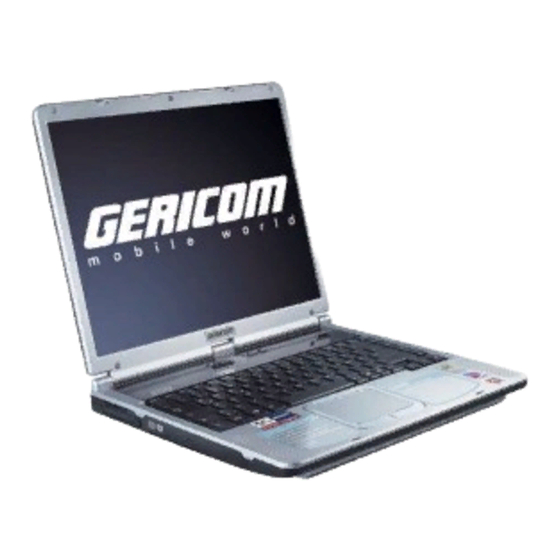
Subscribe to Our Youtube Channel
Summary of Contents for Gericom Ego MS1003
- Page 1 Top-open View Open the top cover, and you can find the main operating area of your computer. 1 - 1...
- Page 2 Display Panel The 15-inch SXGA+/14.1-inch XGA TFT color LCD screen displays the output of the computer. Function Buttons and Power/Resume Button - Email: to launch the E-mail application (such as Outlook Express) to receive/send your E-mail. - Internet: to launch the web browser (such as Internet Explorer) to surf the Internet.
-
Page 3: Right-Side View
Right-side View Right-side View Right-side View Right-side View Right-side View Knowing the components on the right side of your computer. Cover Button Press this button to open the top cover. System LEDs - Wireless LAN: glows Green to indicate the wireless LAN function of the computer is enabled. -
Page 4: Left-Side View
Left-side View Left-side View Left-side View Left-side View Left-side View Knowing the components on the left side of your computer. 4-in-1 Card Reader The built-in card reader supports MMC (multi-media card), SD (secure digital), SM (smart media), and MS (memory stick) cards. PC Card Slot The computer provides a PC card slot to support one Type-II PC card for expansion functions, such as LAN/WLAN card, modem card, memory card,... -
Page 5: Rear View
Rear View Rear View Rear View Rear View Rear View Your Notebook PC provides many I/O ports on the rear panel. Kensington Lock This port is used to lock the computer to a location for security (see Caring Your Notebook PC in Chapter 7 for more information). Ventilator The ventilator is designed to cool the system. - Page 6 Parallel Port The 25-pin D-sub parallel port allows you to connect a parallel device, such as the printer and scanner. USB Ports The USB 2.0 ports allow you to connect low-speed peripheral devices, such as the mouse, keyboard, modem, external hard disk module, printer, and more. IEEE 1394 Port The IEEE 1394 port is a high-speed bus that allows you to connect high-end digital devices such as the DV (digital video camera).
-
Page 7: Bottom View
Bottom View Bottom View Bottom View Bottom View Bottom View Carefully put the computer upside down, and you can find the core components of the computer. 1 - 7... - Page 8 Battery Unlock Button If you want to replace a battery, press and slide the button to remove the battery pack. Battery Pack To supply power to your computer when the AC adapter is not connected (see Chapter 4 for more information). Memory Compartment The computer provides two SO-DIMM slots for expanding the memory size up to 1GB.
-
Page 9: Connecting The Power
Connecting the Power Connecting the Power Connecting the Power Connecting the Power Connecting the Power Your Notebook PC is equipped with a high-performance 8-cell Li-ion battery pack, and it can operate either on the battery’s power or AC power. However, for the first time to use your Notebook PC, it is recommended to connect the AC adapter and use the AC power. - Page 10 Open LCD Panel Open LCD Panel Open LCD Panel Open LCD Panel Open LCD Panel Now, when the AC adapter is connected, you are ready to use your computer. Opening the Top Cover First, open the top cover by pressing the cover button on the right side of the computer ( ), and then lifting the top cover gently ( ).










Need help?
Do you have a question about the Ego MS1003 and is the answer not in the manual?
Questions and answers